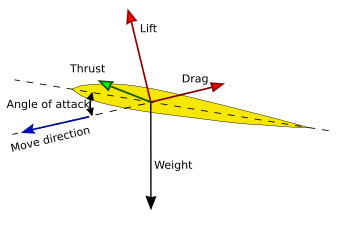Lift (force) facts for kids
The lift force, lifting force or simply lift is the sum of all the forces on a body that force it to move perpendicular to the direction of flow.
The most common type of lift is that of a wing of an aircraft. But there are many other common uses such as propellers on both aircraft and boats, rotors on helicopters, fan blades, sails on sailboats, and wind turbines.
While the common meaning of the term "lift" suggests an "upwards" action, lift can be in any direction. For instance, for a sail the lift is horizontal, and for the wing on a race car the lift is down.
There are a number of ways of explaining the production of lift; some are more complicated than others, some have been shown to be false. The simplest explanation is that the wing deflects air downward, and the reaction pushes the wing up.
Images for kids
-
Flow around an airfoil: the dots move with the flow. The black dots are on time slices, which split into two – an upper and lower part – at the leading edge. A marked speed difference between the upper-and lower-surface streamlines is shown most clearly in the image animation, with the upper markers arriving at the trailing edge long before the lower ones. Colors of the dots indicate streamlines.
-
Control volumes of different shapes that have been used in analyzing the momentum balance in the 2D flow around a lifting airfoil. The airfoil is assumed to exert a downward force −L' per unit span on the air, and the proportions in which that force is manifested as momentum fluxes and pressure differences at the outer boundary are indicated for each different shape of control volume.
See also
 In Spanish: Sustentación para niños
In Spanish: Sustentación para niños












